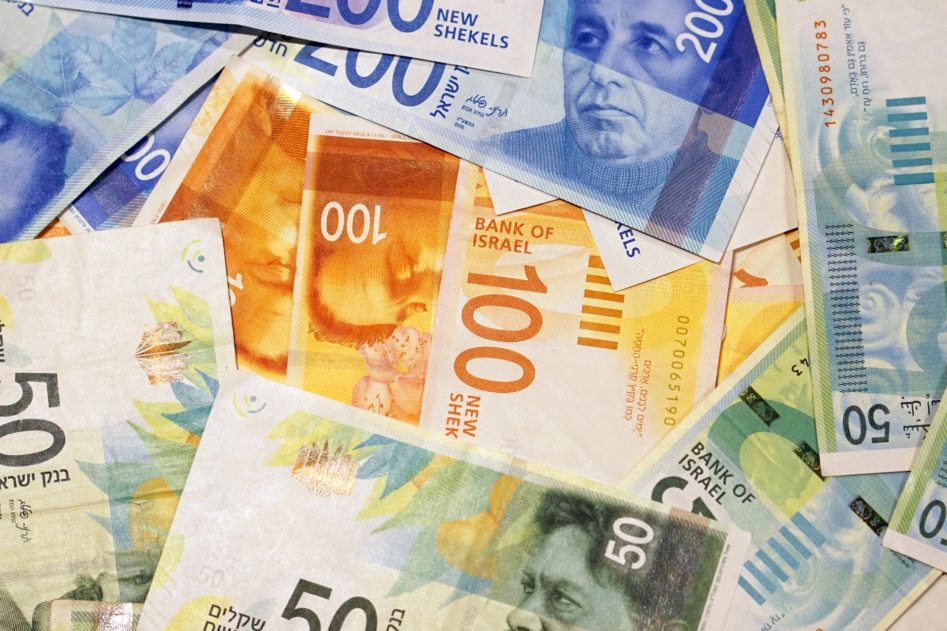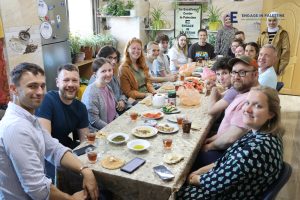Money matters: Every year, Palestine is visited by hundreds of thousands of tourists and travelers looking for an adventure in one of the most ancient places on the planet. It is rich in history and culture, has amazing cuisine, and is religiously diverse.
Whether you intend to go to the West Bank, Palestine, for language education, volunteering, diplomatic reasons, or just looking for a new adventurous trip, preparing for such a journey requires a lot of research and preparation. Consequently, money-related questions tend to arise at this point, such as How will I pay for things there? Will I be able to exchange my currency with the Palestinian one? Are there ATMs available? And questions about the cost of living there are also very important.
This article will help you answer money-related questions in Palestine, especially in the West Bank.
- What currency is used in the West Bank and Gaza?
- ATMs and access to money
- Banks and monetary system
- Money transfer and currency exchange
- Can I pay with my card?
Table of Contents
Which Currency Is Used In Palestine?
Throughout Palestine’s history, over 28 currencies have been used here. The short answer is that today the main currency in the West Bank and the Gaza Strip is the the New Israeli Shekel (NIS). Since the signing of the Paris Protocol in 1994, the Palestinian economy has been dependent upon the Israeli economy.
Additionally, since the Oslo Accords were signed in 1993, the New Israeli Shekel, the US Dollar, and the Jordanian Dinar are all accepted as payment. In some cases, it can also be possible to pay in Euros. Generally, any change due will be given in shekels when paying with a currency other than the shekel.
But how did the currency of Palestine come to be the New Israeli Shekel, and what about the Shekel? Is it new? Keep reading to find a brief recent history of currency in Palestine.
Currency During The Ottoman Empire And British Mandate (Pre-1948)
Before the First World War, Palestine was under the rule of the Ottoman Empire from 1516 until it was occupied by the British in 1918. As part of the Ottoman Empire, the currency used in Palestine was the Ottoman Lira. Coins were primarily used with paper bank notes, which began to appear in Palestine in 1914.
When the British Mandate of Palestine began in 1920, both the Ottoman Lira and Egyptian Pound were used for daily transactions, but this stopped in 1927. In 1927 the British Colonial Council’s Currency Committee introduced a new currency with the same value as the British Pound (the Pound Sterling) – the Palestinian Pound.
From 1948 – 1980
After the establishment of the State of Israel in historic Palestine in 1948, the Palestinian Pound continued to be used until it was replaced by the Israeli Lira (also called the Israeli Pound) in 1952. During this time, the West Bank became part of Jordan, and the Gaza Strip became part of Egypt.
So the Palestinian Pound was phased out and completely replaced by 1950-1951 with the Jordanian Dinar (in the West Bank) and Egyptian Pound (in Gaza). These were then replaced with the Israeli Lira by Israel after it seized and began militarily occupying the West Bank and Gaza Strip in 1967 and closed all Palestinian and Arab banks operating in these areas.
1980 – Present
In 1980, the Israeli Lira was replaced by the Israeli Shekel (sometimes spelled as “shequel”), with 1 Israeli Lira equivalent to 10 Israeli Shekels (now called Old Israeli Shekels). The name “shekels” was used to give the currency a Hebrew name (as “pound” and “lira” are not Hebrew words).
However, the 1970s and 1980s inflation led to this currency becoming hyper-inflated like its predecessor, which was replaced by the New Israeli Shekel in 1986. 1 New Israeli Shekel is equal to 1000 (Old) Israeli Shekels. This currency remains in Israel, the West Bank, and Gaza today.
New Israeli Shekels
New Israeli Shekels are generally just referred to as “shekels” and are symbolized by this sign (₪). The New Israeli Shekel is divided into 100 Agorot (the plural form of “agora”), just as one dollar is divided into 100 cents. Today, the currency code for the Israeli Shekel is “NIS” for New Israeli Shekel. It is important to remember that if you withdraw money from an ATM in Israel or Palestine, you must withdraw in more than one currency.
NIS Banknotes And Coins
NIS banknotes have undergone several changes and series since being issued in 1985. Since 2014, they have been issued in the following denominations: ₪20, ₪50, ₪100 and ₪200. NIS coins are currently issued in the following denominations: 10 agorot, ₪1/2, ₪1, ₪2, ₪5 and ₪10. Note that the 10 agorot coins (gold in color) are used in Israel but not in the West Bank. Instead, the lowest value used in the West Bank is the ₪1/2 coin, and all purchases will be rounded to the nearest half shekel.
Jordanian Dinars
Jordanian Dinars, usually written as JOD or JD, is Jordan’s official currency and can also be used in Palestine. Like Palestine, Jordan was part of the Ottoman Empire until the League of Nations put the Emirate of Transjordan (as it was called then) under a British protectorate in 1922.
During this time the Palestinian Pound was the currency of Jordan until 1949-1950, when it was replaced by the JOD. The Jordanian Dinar has been pegged to the US dollar since 1995 at the rate of 1JOD = US$0.7090.
Using Jordanian Dinars In Palestine
Today, Jordanian Dinars are often used in Palestine to buy high-value items such as houses, land, cars and animals. There are several Jordanian Banks in Palestine, which should be easy to spot because they usually have “Jordan” or “Amman” (the capital of Jordan) somewhere in their name. Note that Jordanian Bank ATMs will dispense cash in Jordanian Dinars, so always pay attention when using an ATM in Palestine to ensure you get the currency you are looking for.
If you accidentally withdraw some JOD, they are accepted by some shops, who will give you your change in shekels. Otherwise, you can exchange them at a currency exchange office. You will be able to find a variety of ATMs and several exchange offices along Ein Sara (the main street in Hebron), nearby to Engage in Palestine’s center.
Where Can I Obtain Israeli Shekels? Money Transfer And Currency Exchange
It is very easy to exchange money in Hebron, Palestine, as there are several money-changing places on the main street of Ein Sara. For USD, the exchangers do not take any commission from your exchange. Money exchange agencies are spread all over Palestine, especially in the West Bank. It is easy to convert major currencies, and we always advise our students and volunteers to keep track of their currency’s exchange rate compared to the NIS.
However, it is more likely that you will need to find an ATM rather than exchange large amounts of foreign currency. In Hebron, many different ATMs from different banks charge different withdrawal fees and dispense different currencies (JOD, USD, NIS). So, it is important to pay close attention when using an ATM.
ATMs In Hebron
There are many ATMs in Hebron, but they may not all work with international cards. So if you try to use an ATM it either rejects your card immediately or will not dispense money for you, just try another ATM. If you need advice about this matter, our local staff at Engage in Palestine or fellow volunteers can advise you once you arrive.
We recommend our participants use the Bank of Palestine ATM, which is one of several ATMs inside Bravo supermarket. Bravo is located on Ein Sara Street and approximately a seven-minute walk from Engage in Palestine’s center. In our experience, this ATM works the best with foreign cards and is very reliable. It gives the choice of dispensing USD (US Dollars) or NIS (New Israeli Shekels).
ATMs And Access To Money
ATMs are the fastest way to gain access to your money; in Palestine, especially in the West Bank, you can easily find 24-hour working ATMs, mostly in gas stations, major hotels, and malls, and most of them offer the following services:
- Cash Withdrawals
- Check deposit service through some selected ATM’s
- Online Cash Deposit Services
- Balance Inquiry
- Mini Statement (Last 10 transactions)
- Utility Bill Payment (Paltel, Jawwal and Ooredoo)
- Add Credit to your mobile phone from Jawwal.
- Credit card services (Card information, recent transactions, and card payments)
- Cash Withdrawal and Balance Inquiry services to Visa International
Banks And Monetary System
The Palestinian banking system has expanded rapidly in the last six years, and today 23 banks operate in the West Bank and Gaza. Foreign banks have a heavy presence, and 14 out of the 23 banks are branches of foreign banks (nine Jordanians, two British, two Egyptians, and one Israeli).
Here is a list of the major banks in Palestine:
| Bank of Palestine | Arab Islamic Bank |
| Palestine Islamic Bank | Palestine Investment Bank |
| Al Quds Bank | The National Bank TNB |
| Cairo Amman Bank | Housing Bank |
| Arab Bank | Egyptian Arab Land Bank |
| Jordan Ahli Bank | Commercial Bank of Jordan |
Can I Pay With My Card?
That is a very important question for folks who do not like carrying cash on them all the time and are accustomed to paying with their debit or credit cards. It is important to note that paying by card is not common in Palestine. Palestinians do not generally use cards to make day-to-day purchases, although major supermarkets usually accept cards. Bank cards are mostly only used to withdraw money from ATMs.
Nonetheless, there are some shopping places in Palestine which accept cards as a way of payment, this isn’t very common but is becoming a little more common with time. You should carry a small amount of cash for your daily expenses and withdraw from an ATM when necessary.
Many Palestinian banks, such as the Bank of Palestine, issue different types of payment cards.
Be aware that the Bank of Jordan, the Arab Bank, and the Cairo Amman Bank only give money in Jordanian dinars, which must be further exchanged into NIS.
Life in Israel is much more expensive than living in any city on the West Bank. If you are traveling to both Palestine and Israel, take this point into consideration.
Final Remarks
Whether you are traveling to Palestine for fun, as a tourist, to study Arabic, for career prospects, or even for religious reasons, the West Bank is an excellent place for you to start. However, financial matters are very important issues that you should thoroughly plan.
Please also remember that our staff are always ready to help you before and during your trip. To elaborate on how we can help you, our staff will answer all your questions about financial practicalities and roughly how much money you will need during your stay. Our staff will also gladly show you where you can use your card, where the ATMs and banks are located, and, more importantly, where you can exchange your currency for NIS.
We will be more than thrilled to be part of and guide you through your journey.
Should you have any questions, please do not hesitate to contact us at Info@ecpalestine.org
Whatsapp:+972599479880
For more information, please visit our website: https://excellencenter.org/
Excellence Center’s Facebook page: https://www.facebook.com/ExcellenceCenter
Excellence Center’s Facebook account: https://www.facebook.com/RafatECHebron
Watch us on Youtube: https://www.youtube.com/channel/UCsQSLdFZWZcBm6Uj0XMYuKg
Visit and Explore Palestine: https://www.facebook.com/ExplorePalestine



